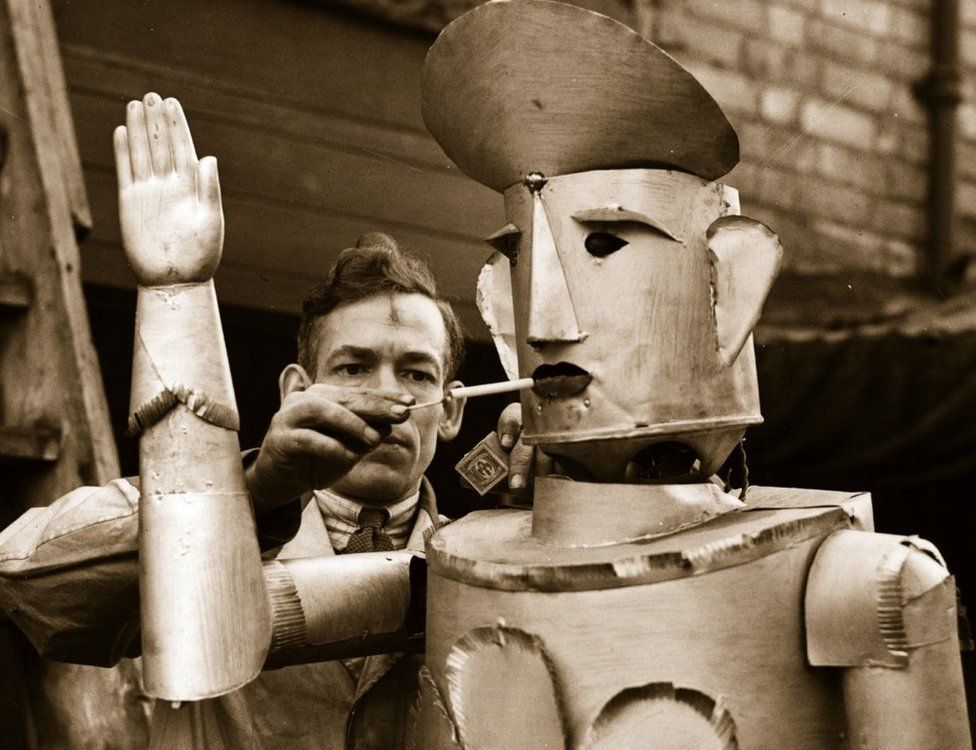What happened to Robert the smoking robot?
- Published

More than 80 years ago, a robot could be found in the unlikely surroundings of Kettering, directing traffic and smoking a cigarette.
Today, the story of Robert the Robot is little known, even in the Northamptonshire town where he was once a celebrity.
Yet in the 1930s, his fame reached as far as Czechoslovakia and the United States, where he even featured in Time magazine.
And the reason he came to be?
"Someone bet me £5 I could not make a robot in three weeks," inventor Charles Lawson, who had a radio shop, told a newspaper at the time.
"I won."
Robert could be seen outside Mr Lawson's shop in Wellington Street, Kettering
The electrical engineer's creation first hit headlines in the Northamptonshire Evening Telegraph, which proclaimed: "Kettering robot 'enjoys' smoke."
The article from March 1939 proclaimed the android could do "practically everything that a human being can do", even crediting him with the "ability of mind reading".
"You may pick up a card from a pack and the robot will tell you the card you have chosen," it read.
"It has a sense of humour too, for when Mr Lawson was bending down to examine its leg he received a slap on the face."
So how did he function? Frustratingly, it is not entirely clear.
Robert was popular with children and could also - apparently - direct traffic
The only remaining evidence for his existence are a selection of photographs and Robert himself disappeared from view after World War Two.
Mr Lawson's son David, an 84-year-old retired farmer, remembers "wires and gears, a maze of chains and electronics" inside the robot's 10ft-tall frame.
He said his father had built a prototype in 1938, which he had installed in Kettering's Temperance Hall.
The robot had a microphone and speaker in its head and hidden assistants would surprise the unsuspecting people walking past.
"They (the assistants) would be looking down at people passing by and suddenly say something about someone's pink hat," he said.
His father then moved on to the more advanced Robert, who could move his arms and hands.
The Meririam Webster dictionary used a picture of Charles Lawson's robot in an advert
"It used to light its own cigarettes. It even directed the traffic in Kettering," David Lawson said.
"It even used to tell fortunes and he took it to the seaside, including trips to Blackpool. [My father] got obsessed with it."
Robert was one of the first robots seen in the UK. The very term robot was less than 20 years old, having been coined by Czech writer Karel Capek in his 1920 play RUR, external.
The first British robot is believed to have been constructed in 1928 and was called Eric. He was subsequently rebuilt and is on display at the Science Museum in London.
Noel Sharkey, professor of robotics at Sheffield University and head judge on BBC Two's Robot Wars, said it was most likely Robert was a similar construction to Elektro, a robot made by US power company Westinghouse in 1937 for the New York World's Fair in 1939.
Robert first hit the headlines in the Northamptonshire Evening Telegraph
"As is claimed for the Charles Lawson robot, it could walk, talk, smoke and count," he said.
"The robot relied on a combination of motors, photoelectric cells, telephone relays and a record player to perform 26 pre-programmed routines, each one initiated by voice commands from a human co-star.
"Smoking was done using automated bellows which were also a feature of 19th Century automatons.
"Remember that this type of robot did not have access to a computer and so talking was done using a triggering mechanism for a record player playing old 78 RPM bakelite records."
Science fiction was in vogue in the 1930s - serials such as Flash Gordon were popular in the cinemas - and Robert became a huge media sensation, drawing the attention of English newspapers.
His story was then syndicated abroad where it was eagerly reported by the foreign press.
The entry in one Czech newspaper, under the headline Robot Friend of the Children, read: "In the English town of Kettering a robot often appears in the streets, it strides, sits down, smoke and speaks.
The robot was shown in displays at theatres in Kettering and received coverage in Czech newspapers
"The steel servant is an invention of C. Lawson, once an electric tramway employee. The robot has a sound apparatus in its head.
"Every move of the robot is followed, chiefly by the crowd of young folk, especially when he is on point duty."
Mr Lawson tried to capitalise on Robert's fame, exhibiting him around the country. His son said he eventually sold him to a pier showman in Blackpool shortly before the start of World War Two.
Despite several attempts to trace him, Robert's whereabouts remain unknown. But it seems possible he enjoyed a post-war career as a seaside attraction before disappearing into obscurity.
Tony Sharkey, head of local history at Blackpool library, said robots often appeared in sideshows during the 1950s, including one from South Africa called Magna.
"From images I've seen it appears to have been very different [to Robert]. The show included illusions and the robot would mind read and tell people what they were wearing."
Mr Lawson sold his shop in the 1960s and retired, but although he was "quiet man" he would talk to people about his robots if asked.
He died in 2002 in Kettering, aged 96.
"It is only recently when I've thought about the complexity of the robot that I realised how clever he was," his son said.
Mr Lawson often staged events in Kettering to publicise his robot and his radio shop
- Published26 February 2017
- Published20 January 2016